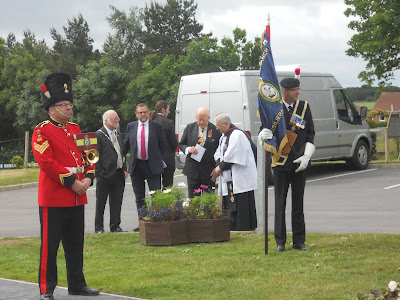 |
| The Pals' memorials at Bus-les-Artois, France, photograph by permission of Brian Stobie |
“Our battalion was reserve - with the exception of D Coy - to the 93rd Infantry Brigade, 31st Division in the 8th Army Corps commanded by General Sir Aylmer Hunter-Weston. The other battalions in the brigade were the 15th (Leeds Pals) West Yorkshire Regiment, and the 16th and 18th (Bradford Pals) West Yorkshire Regiment. The Leeds Pals, with our ‘D’ Coy, were to be the first wave over the top, followed at half hour intervals by each battalion of the Bradfords.”
– Charles Moss, 18th Battalion, Durham Light Infantry
A memorial stone dedicated to the Durham Pals is being unveiled at a ceremony in France this weekend.
The stone has been installed in the small hamlet of Bus-Les-Artois where 18th Battalion Durham Light Infantry (18 DLI) – known as the Durham Pals – were stationed in the lead up to the Battle of the Somme.
 |
| Installing the Durham Pals memorial at Bus-le-Artois, France, photograph by permission of Brian Stobie |
The official unveiling of the memorial stone will take place on the evening of Saturday 30 June 2018, during a commemorative service attended by Durham County Council Chairman Cllr John Lethbridge and members of the DLI Association.
Cllr Lethbridge said: “It is extremely important to recognise the sacrifice of the Durham Pals and we are delighted that a permanent memorial has now been installed in an area the battalion had such strong links with”.
 |
| Close up of the Durham Pals memorial, Bus-le-Artois, France, photograph by permission of Brian Stobie |
The Pals, were part of the attack at Serre, at the northern end of the Somme battlefield. By 5 July, the battalion that had gone into the trenches on 30 June almost 800 strong, had suffered almost 500 casualties, including 70 dead. One of the survivors was Lance Corporal Charles Moss, and you can read extracts from his memoir of this battle:
and, the full transcript on Durham at War http://www.durhamatwar.org.uk/material/597/
In 2016, a fundraising appeal culminated in the installation of two memorial benches, one on the Durham riverbanks where the 18 DLI began their journey to France, and the other in Thiepval to mark the end of their fateful journey into battle.
 |
| Directions to the Pals' memorials, photograph by permission of Brian Stobie |










